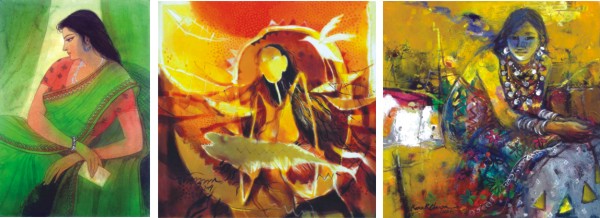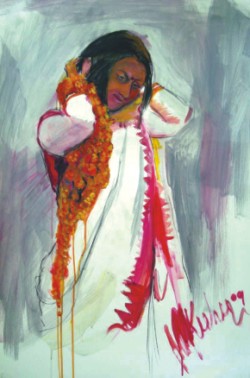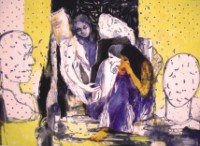|
Art
Art for Charity
Fayza Haq
 |
Fareha Zeba, Mask-2. |
“Shako" means a bridge. This is a coming together of prominent women artists of Bangladesh to do charitable work through exhibitions. Started about seven years ago, Shako gives scholarships to needy artists, helps sick and ailing painters. Among the senior artists at Shako are artists like Dr Farida Zaman , Naima Haque, Nasreen Begum and Fareha Zeba. The younger artists are Farzana Islam Milky, Rabecca Sultan Molly and Shulekha.
"It gives donations” explains Zeba, “as in the case of Shawkuttuzaman, when he was undergoing treatment in India in 2004. A house show was held, which contained paintings by Farida Zaman and Showkuttuzaman as well as paintings by other "Shako' members. Our first workshop was held in 2003 to raise funds for the 'differently abled' at CRP.
Shako also tries to hold a water-colour competition every year. This is to revive interest in this medium.
“At first we gave scholarships through the funds raised in this manner” says Zeba. “Later on, we roped in about 50 art students from the Institute of Fine Arts, DU."
This year, other art students from UDA (University of Alternative Art) have been included too in the competition.
Shako has also been active in raising funds for Tsunami victims and for treating recovering drug addicts.
Profiles of major Shako artists
Fareha Zeba- Mirror of the turbulent present
Fareha Zeba, is an experimental artist, feted by her senior teachers of the Fine Arts Dept., DU.
Stressing on her transition over 25 years for creating melancholic compositions, rather than the optimistic ones that one found in her a student artist, Zeba explains that her departure from an optimistic outlook is due to the socio-political and economic upheavals in life around her, in Bangladesh, and Dhaka. She says that she is now more aware of the acute needs of women and children -- specially the abused and the abandoned ones. She is concerned with the superficial values of the Dhaka bourgeois, and attempts to stir her viewers, so that they become aware of the prevailing, grave socio-economic situation .
Says Zeba: " During the political upheavals that followed -- which made the women, young and old their mouthpieces -- and got them involved, in the stampede for political agitation. As a consequence, women suffer both in public and private." The relative lull of the mid '70s political scenario is over, Zeba says. Now, she says, the women are definitely more involved and motivated in all aspects and that leads to more complexities, suffering and frustrations. Similarly, Zeba adds, the women have gone forward economically.
Nasreen Begum: Oriental art sans overt ornamentation
When Nasreen Begum, an eminent artist, was admitted to the Art College in 1975, she had followed Chughtai's style taking images from cards and calendars. However, having graduated from Baroda's Maharaja Sayajirao's University, she developed a style of her own where she experimented outside the confines of the traditional dictates and grammar. She wanted to combine the western watercolour technique with the Oriental watercolour dictates. “ Now we try to finish the work at one go whereas earlier we applied numerous washes. The subject matter is definitely in keeping with contemporary life while I use the Oriental technique although even the latter has seen a change,” Nasreen adds.
 |
Nasreen Begum, Birohini. Dr Farida Zama, Dead Fish. And Kanak Chanpa Chakma |
In Nasreen's exhibition at “Chitrak” she had continued with her “Door of a new life” series that had continued from 1992-95. The door had been a symbol of Nasreen's belief that new encounters must be overcome in one's progress in life. She had dealt with the “Leaves” and “Cacti” series. The difference between the earlier “Door” series and the present paintings was that the paintings are more abstract and the door now is presented as an open one, which is more decorative and contains washes of brighter and buoyant colours. The red in the painting stands for strength, while the Chinese ink has been used to bring in variation. The red too is used in gradations, verging from pink to maroon. “I'm gradually going in for minimisation. I feel this relates to my present life, which too has been simplified”. Thus circles, rectangles and triangles, found in the works like “The red door,' A'” have been used in a simple manner” represent hopeful expectations. The flowers, human figures and inclusion of the moon in another work also brings in a variation of the same bold but minimized colours. Another of her work presents a close-up of a single broken shell seen with the sea and the sand around .
 |
Kuhu, Pohela Falgun. |
Dr Farida Zaman: Of fragile fish nets, rivers and misty skies
When working the female figure comes on my canvas,” says Dr Farida Zaman, “I work with female emotions but this is done unconsciously. Very often I portray the fisherwoman. I feel that women can work wonderfully, and are struggling hard, side by side with men. When I first went to study in Baroda I noticed women's participation in our economic and social life. I was amazed at their tenacity and dedication. I normally bring in the moonlight, weeds, flowers and water.”
In her work she was inspired by the work of Zainul Abedin, Qamrul Hassan, Hashem Khan, Monirul Islam. When she roamed around the countryside in her youth and even when she visits her home in Chandpur today she mentally studies the beauty of nature. The visions of Subrananayam and Ganesh Payne in India also encouraged her to forge ahead. From the west Farida has always admired Matisse and Picasso. “ I take my inspiration mostly from nature and from then on I work as my own, putting in my lines and colours as they suit me,” says Farida.
Farida is not taken up by the restlessness and competitiveness of contemporary life. She makes simple, uncomplicated images of village life and its surroundings. She fills it up with fish, cat, stork, fishermen, women and small pools. She has gone through difficult days and yet she manages to devote her time to painting with her dots and lines. She even abandoned the position of the Director of the Institute of Fine Arts to devote all her time to painting.
Kanak's quintessentially ethnic vision --
Kanak Chanpa Chakma began at the Fine Art Institute from her home among the hills, being inspired by her mother Sarat Mala Chakma, who has won international awards for her handloom work. Kanak presents the ambiance of her childhood days in her canvas and mixed media pieces and naturally feels enormous pride in holding up a mirror to her happy youth to connoisseurs and art lovers both at home and overseas. Never before were even the Bangladeshis aware of the numerous indigenous groups of people. Kanak wanted to make her viewers aware of the multi-cultural richness of the country.
When Kanak began her career, she did sculpture and print along with her painting but now she has decided to settle in for oil, acrylic and mixed media with canvas as the surface. Rangamati's exotic hills reflect the happy and contented, simple but beautiful life. Kanak has always been specially influenced by the French impressionists Matisse and Gauguin. As a student, she admired many of her teachers and senior counterparts, but was bent on creating a niche for herself with a unique style and subject.
Nancy Sperio, from USA, however, has influenced her focus on women and her desire to establish a strong individuality of her own. She is also an ardent admirer of MF Hussain, Ganesh Payn and Bikash Bhattacharya, from India. She marvels at the depth of perception and powerful strokes in their modern creations and their love for representational work on flat surfaces. " They combine the east with the west, as do my earlier mentors," says Kanak. Today, she has an amphitheater to perform in, with numerous nonpareil accolades, from both at home and abroad.
 |
Naima Haque, Golden Cage. |
Kuhu's fixation for female figures--
Kuhu 's delineations of sensuous dusky women, peeping though curtains of Dhaka rickshaws, are memories of her student days at the Institute of Fine Arts, years back. Through the image of the attractive women with flowing hair, sensuous lips, luminous eyes and eager looks she recalls her trips though Dhaka before she went to study at Dieppe, France.
Although Kuhu had to undergo the rituals of outdoor academic training in her student years, it was portraiture that she enjoyed most, being guided by the now Spain based Shahid Kabir and Rafiqun Nabi. Her colleagues like Jamal Ahmed and Nasreen Begum gave her more incentive and competition. Today her drawings in marvelous vermilions, blues and earthy hues are unique indeed, and they follow the features of her muse Fatima, her favourite model in Gulshan.
Kuhu brings in the motifs of the rickshaw painters with exotic flowers and vines, suggestion of rickshaw curtains and other integral parts. She then fits in her nebulous models. She sometimes adds interlacing flora and fauna to her main subjects This is in order to lend interest and variation.
Naima: From painting to graphics
Naima Haque, who is an illustrator, free-lance artist cum teacher at the Institute of Fine Arts DU, did her Masters in Graphics Design from Barodha. Her teachers in India included Jairam Patel and Sant, while her guides in Bangladesh were Aminul Islam, Abdul Basset, and Rafiqun Nabi. "I was in the batch with Farida Zaman and Shamim Shikdar", she says." I wanted to study painting but was compelled to study graphics as my arrival at Barodha was late due to unfortunate delay due to red tape. I had a lot of encouragement for preparing my final presentation portfolio. As graphics was not my choice, I treated the subject as a challenge. When I told my teacher that I didn't think much of graphics as I'd seen my teachers doing illustrations as a secondary pastime in Dhaka, this provoked one of my teachers. Back home, our teaching was often mostly academic, but alongside, they had also encouraged experimentation."
Earlier on Naima didn't think much of illustrations but later she realised that it was parallel to painting. The only difference was that in graphics one waited for the client to give the subject.
"Hashem Khan, Rafiqun Nabi and Qayyum Chowdhury, in their paintings illustrated their experiences and thoughts, bringing in scenes dear to their hearts. Similarly, in illustrating, I also put in my own feelings and not just what the clients dictate," says Naima.
Copyright
(R) thedailystar.net 2010
|

